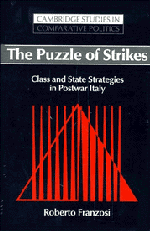Book contents
- Frontmatter
- Contents
- List of tables, figures, and equations
- Dedication
- Preface
- Acknowledgments
- 1 The puzzle box
- 2 Labor-market conditions and bargaining power
- 3 When do workers strike? How the economy matters
- 4 Organizational resources and collective action
- 5 The structure of collective bargaining
- 6 Class power, politics, and conflict
- 7 Mobilization processes: the 1969 autunno caldo
- 8 Countermobilization processes: reactions by the state and employers to strike waves
- 9 The picture in the puzzle
- Epilogue
- Appendix: the data
- Notes
- Bibliography
- Index
4 - Organizational resources and collective action
Published online by Cambridge University Press: 08 January 2010
- Frontmatter
- Contents
- List of tables, figures, and equations
- Dedication
- Preface
- Acknowledgments
- 1 The puzzle box
- 2 Labor-market conditions and bargaining power
- 3 When do workers strike? How the economy matters
- 4 Organizational resources and collective action
- 5 The structure of collective bargaining
- 6 Class power, politics, and conflict
- 7 Mobilization processes: the 1969 autunno caldo
- 8 Countermobilization processes: reactions by the state and employers to strike waves
- 9 The picture in the puzzle
- Epilogue
- Appendix: the data
- Notes
- Bibliography
- Index
Summary
A challenger, to be effective, needs organization … to pry loose time, money and commitment … to focus prism-like these resources upon the arena of central state politics.
Shorter and Tilly (1974, p. 147)Trades unions in England, as well as in every other manufacturing country, are a necessity for the working classes in their struggle against capital … If a whole trade of workmen form a powerful organization … then, and then only, have they a chance.
Karl Marx (Lapides, 1987, p. 105)Trade unions … are the types of proletarian organization specific to the historical period dominated by capital. In a certain sense it can be argued that they are an integral part of capitalist society, and that they have a function which is inherent in the regime of private property.
Antonio Gramsci (1954, p. 36)SHIFTING GEARS
The findings in Chapters 2 and 3 have shown that economic models go a long way toward explaining Italian strikes. Yet the findings have also revealed the limits of this type of model for the Italian case. In particular, economic models do not explain why the statistical relationships to economic factors should be stronger for strike frequency than for other strike components, nor can they identify the noneconomic determinants that lie behind strike size, duration, and volume. The economic literature has very little to say on these points (Skeels, 1971). The economic strike literature has even less to say about why, under unfavorable labor-market conditions, the Italian working class has been less militant than would seem warranted by economic factors alone (paradox of the génie d'un peuple).
- Type
- Chapter
- Information
- The Puzzle of StrikesClass and State Strategies in Postwar Italy, pp. 96 - 142Publisher: Cambridge University PressPrint publication year: 1995

